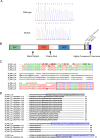Whole genome variant association across 100 dogs identifies a frame shift mutation in DISHEVELLED 2 which contributes to Robinow-like syndrome in Bulldogs and related screw tail dog breeds
- PMID: 30521570
- PMCID: PMC6303079
- DOI: 10.1371/journal.pgen.1007850
Whole genome variant association across 100 dogs identifies a frame shift mutation in DISHEVELLED 2 which contributes to Robinow-like syndrome in Bulldogs and related screw tail dog breeds
Abstract
Domestic dog breeds exhibit remarkable morphological variations that result from centuries of artificial selection and breeding. Identifying the genetic changes that contribute to these variations could provide critical insights into the molecular basis of tissue and organismal morphogenesis. Bulldogs, French Bulldogs and Boston Terriers share many morphological and disease-predisposition traits, including brachycephalic skull morphology, widely set eyes and short stature. Unlike other brachycephalic dogs, these breeds also exhibit vertebral malformations that result in a truncated, kinked tail (screw tail). Whole genome sequencing of 100 dogs from 21 breeds identified 12.4 million bi-allelic variants that met inclusion criteria. Whole Genome Association of these variants with the breed defining phenotype of screw tail was performed using 10 cases and 84 controls and identified a frameshift mutation in the WNT pathway gene DISHEVELLED 2 (DVL2) (Chr5: 32195043_32195044del, p = 4.37 X 10-37) as the most strongly associated variant in the canine genome. This DVL2 variant was fixed in Bulldogs and French Bulldogs and had a high allele frequency (0.94) in Boston Terriers. The DVL2 variant segregated with thoracic and caudal vertebral column malformations in a recessive manner with incomplete and variable penetrance for thoracic vertebral malformations between different breeds. Importantly, analogous frameshift mutations in the human DVL1 and DVL3 genes cause Robinow syndrome, a congenital disorder characterized by similar craniofacial, limb and vertebral malformations. Analysis of the canine DVL2 variant protein showed that its ability to undergo WNT-induced phosphorylation is reduced, suggesting that altered WNT signaling may contribute to the Robinow-like syndrome in the screwtail breeds.
Conflict of interest statement
The authors have declared that no competing interests exist.
Figures




Similar articles
-
Canine DVL2 variant contributes to brachycephalic phenotype and caudal vertebral anomalies.Hum Genet. 2021 Nov;140(11):1535-1545. doi: 10.1007/s00439-021-02261-8. Epub 2021 Feb 18. Hum Genet. 2021. PMID: 33599851 Free PMC article.
-
DVL3 Alleles Resulting in a -1 Frameshift of the Last Exon Mediate Autosomal-Dominant Robinow Syndrome.Am J Hum Genet. 2016 Mar 3;98(3):553-561. doi: 10.1016/j.ajhg.2016.01.005. Epub 2016 Feb 25. Am J Hum Genet. 2016. PMID: 26924530 Free PMC article.
-
Autosomal dominant Robinow syndrome associated with a novel DVL3 splice mutation.Am J Med Genet A. 2018 Apr;176(4):992-996. doi: 10.1002/ajmg.a.38635. Am J Med Genet A. 2018. PMID: 29575616
-
A novel frameshift mutation of DVL1-induced Robinow syndrome: A case report and literature review.Mol Genet Genomic Med. 2022 Mar;10(3):e1886. doi: 10.1002/mgg3.1886. Epub 2022 Feb 9. Mol Genet Genomic Med. 2022. PMID: 35137569 Free PMC article. Review.
-
Tomographic Study of the Malformation Complex in Correlation With the Genotype in Patients With Robinow Syndrome: Review Article.J Investig Med High Impact Case Rep. 2020 Jan-Dec;8:2324709620911771. doi: 10.1177/2324709620911771. J Investig Med High Impact Case Rep. 2020. PMID: 32172608 Free PMC article. Review.
Cited by
-
Canine DVL2 variant contributes to brachycephalic phenotype and caudal vertebral anomalies.Hum Genet. 2021 Nov;140(11):1535-1545. doi: 10.1007/s00439-021-02261-8. Epub 2021 Feb 18. Hum Genet. 2021. PMID: 33599851 Free PMC article.
-
Whole Genome Level Analysis of the Wnt and DIX Gene Families in Mice and Their Coordination Relationship in Regulating Cardiac Hypertrophy.Front Genet. 2021 Jun 8;12:608936. doi: 10.3389/fgene.2021.608936. eCollection 2021. Front Genet. 2021. PMID: 34168671 Free PMC article.
-
BOAS in the Boston Terrier: A healthier screw-tailed breed?PLoS One. 2024 Dec 31;19(12):e0315411. doi: 10.1371/journal.pone.0315411. eCollection 2024. PLoS One. 2024. PMID: 39739830 Free PMC article.
-
A comprehensive biomedical variant catalogue based on whole genome sequences of 582 dogs and eight wolves.Anim Genet. 2019 Dec;50(6):695-704. doi: 10.1111/age.12834. Epub 2019 Sep 5. Anim Genet. 2019. PMID: 31486122 Free PMC article.
-
Dog10K: an international sequencing effort to advance studies of canine domestication, phenotypes and health.Natl Sci Rev. 2019 Jul;6(4):810-824. doi: 10.1093/nsr/nwz049. Epub 2019 Apr 10. Natl Sci Rev. 2019. PMID: 31598383 Free PMC article.
References
-
- Olsson M, Meadows JR, Truve K, Rosengren Pielberg G, Puppo F, Mauceli E, et al. A novel unstable duplication upstream of HAS2 predisposes to a breed-defining skin phenotype and a periodic fever syndrome in Chinese Shar-Pei dogs. PLoS Genet. 2011;7(3):e1001332 10.1371/journal.pgen.1001332 - DOI - PMC - PubMed
-
- Truve K, Dickinson P, Xiong A, York D, Jayashankar K, Pielberg G, et al. Utilizing the Dog Genome in the Search for Novel Candidate Genes Involved in Glioma Development-Genome Wide Association Mapping followed by Targeted Massive Parallel Sequencing Identifies a Strongly Associated Locus. PLoS Genet. 2016;12(5):e1006000 Epub 2016/05/14. 10.1371/journal.pgen.1006000 ; PubMed Central PMCID: PMC4865040. - DOI - PMC - PubMed
Publication types
MeSH terms
Substances
Supplementary concepts
Grants and funding
LinkOut - more resources
Full Text Sources
Medical
Research Materials
Miscellaneous

